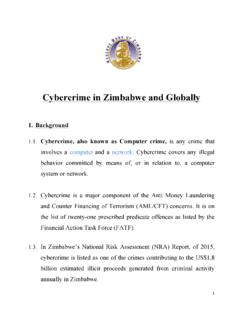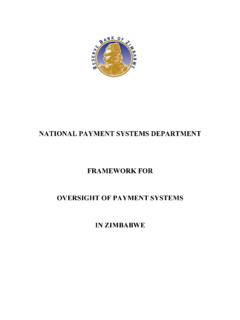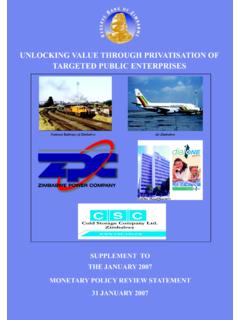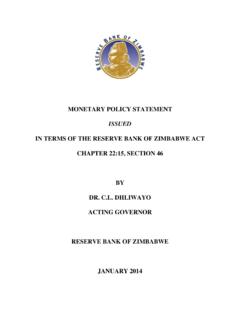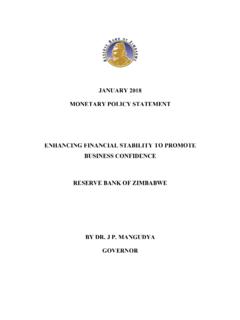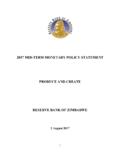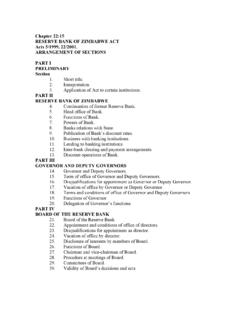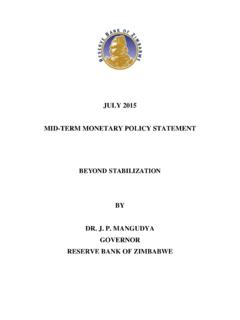Transcription of GROWTH DYNAMICS BY S. Nyarota1, W. Kavila2, N. Mupunga3 ...
1 AN EMPIRICAL ASSESSMENT OF BINDING CONSTRAINTS TO ZIMBABWE'S. GROWTH DYNAMICS . BY. S. nyarota1 , W. kavila2 , N. Mupunga3 and T. Ngundu4. RBZ WORKING PAPER SERIES 2015. 1. Director, Economic Research 2. Deputy Director, Economic Research 3. Deputy Director, Economic Research 4. Senior Economist, Economic Research ABSTRACT. This paper provides an analysis of the GROWTH diagnostic for Zimbabwe using the framework proposed by Hausman and Velasco (2004). An econometric approach is also applied to assess the sources of economic GROWTH during the period 1980 to 2014. The results suggest a significant decline in productivity and capital stock during the period from 2000 to 2008. The contribution of capital to economic GROWTH was, on average, negative between 1990 and 2008, largely reflecting a contraction of gross fixed capital formation.
2 Labour force participation has remained fairly static, which implies that it might not have been a binding constraint to Zimbabwe's GROWTH . The subdued GROWTH rates for Zimbabwe have, therefore, mainly been attributed to decline in the capital stock and productivity. As such, addressing capital and productivity constrains is critical in jump-starting the economy into a positive GROWTH trajectory. There is, however, need for a clear-cut transition from igniting GROWTH to sustaining it into the foreseeable future. This requires government to put in place appropriate contingency plans to respond to external shocks that have the potential of throwing economic GROWTH in disarray. Keywords: GROWTH Diagnostic, Macroeconomic shocks, Cobb Douglas, Regression Analysis JEL Classification: H63, H62, E62.
3 Disclaimer: The views and conclusions expressed in this paper are those of the authors and do not necessarily reflect the official position of the Reserve Bank of Zimbabwe. For more information concerning the paper do not hesitate to contact the Director, Economic Research, Simon. Nyarota, email address: 2. SECTION ONE: INTRODUCTION. The nature and causes of sustained long-run economic GROWTH have always stimulated intense debate by both economists and policymakers the world over. The scholarly debate about the set of policies needed to promote sustainable economic GROWTH is of particular importance for developing countries and countries in transition. In recent decades, a large literature emerged that intends to explain the underlying mechanisms of sustained economic GROWTH and to assist policymakers in choosing the right policies and reforms.
4 While this strand of the literature has advanced understanding of the nature of economic GROWTH and the set of ingredients needed for sustained economic GROWTH , most of the prescriptions of this literature have remained extremely general. The one size fits all approach, which is exemplified by the Washington Consensus, typically leads to a situation where policymakers are faced with a long list of needed reforms. In practice, however, only a few reforms can feasibly be implemented. In light of these challenges, this paper attempts to assess the binding constraints to Zimbabwe's sustained GROWTH using the GROWTH diagnostic framework by Hausmann, Rodrik and Velasco (2008). The GROWTH diagnostics framework attempts to identify the most binding constraints to economic GROWTH , thus allowing policymakers to prioritize those reforms that relax the binding constraints.
5 By definition, relaxing a binding constraint will raise GROWTH , whereas relaxing a non-binding constraint will not. The analysis is particularly important to Zimbabwe which has been experiencing subdued and unstable economic GROWTH rates since 1980, when the country attained its independence. The World Bank (2000) estimates that an annual average GROWTH rate of about 7 percent, and a better distribution of income, would be needed to achieve the Millennium Development Goals (MDGs) of halving the incidence of severe poverty by 2015. On the background of negative economic GROWTH rates experienced by the country from 2000. to 2008, there has been renewed debate since the adoption of multicurrency system in 2009 on the long run determinants of economic GROWTH . Although Government came up with various economic reforms and blue prints aimed at fostering sustainable economic GROWTH , these have not been very successful.
6 Notable among the reforms include the Economic Structural Adjustment Programme of 1991 to 1995; Zimbabwe Programme of Economic and Social Transformation, 1997; National Economic Recovery Plan, 2003; Macro-Economic Policy Framework 2005; and Short Term Economic Recovery Plan, 2009, among others. 3. In 2013, government came up with another economic blue print, the Zimbabwe Agenda for Sustainable Socio-Economic Transformation (ZimAsset). This policy document was crafted with the objective of achieving sustainable development and social equity anchored on indigenization, empowerment and employment creation, largely propelled by the judicious exploitation of the country's abundant human and natural resources. Although the blue print is well structured, its success depends on buy in from all stakeholders, leading to successful implementation of the various programmes contained in the document.
7 The policy aimed to achieve annual GROWTH rates of 7% in the medium term which is in line with the World Bank recommendation to achieve MDGs. As pointed by Easterly (2001) most policy reforms and aid interventions that followed the logic of a big push in public investment did not support sustained economic inclusive GROWTH . Similarly, structural reforms based on the so-called Washington Consensus set of economic policy reforms across the board (Williamson 1990) mostly failed to yield sustained GROWTH (Rodrik 2007: 86). Nevertheless, for ZimAsset to succeed, there is need for government to identify the major binding constraints to sustainable economic GROWTH . In addition, there is need for crafting of well sequenced policies to address the identified binding constraints and structural rigidities in order to unlock the country's GROWTH potential.
8 Accordingly, this paper provides an analysis of the GROWTH diagnostic for Zimbabwe using historical information to identify binding constraint to sustainable economic GROWTH . The approach entails using an analytical framework to identify the most binding constraints that hamper economic GROWTH at a specific point in time. The results from the analysis will allow policymakers to creatively develop policy designs which address the most binding constraint while taking into account economic, political and social context. The GROWTH diagnostics analysis will also enable authorities to properly sequence and prioritise policy reforms under ZimAsset for sustainable GROWTH and development. This study is organized as follows. The next section discusses and analyses Zimbabwe's GROWTH performance since attainment of independence in 1980.
9 Section three discusses both the theoretical and empirical literature on GROWTH DYNAMICS and some common pitfalls of the literature. Section four discusses the methodology of the study. Section five presents and 4. analyses the empirical results, while section six concludes and offers policy recommendations on various constraints to Zimbabwe's economic GROWTH . SECTION TWO: OVERVIEW OF ZIMBABWE'S GROWTH DYNAMICS . This section provides some stylized facts about GROWTH performance in Zimbabwe during the period 1980 to 2014. Zimbabwe's annual economic GROWTH rate averaged around from 1980 to 2014, weighed down by the decline in economic activity from 1998 to 2008, with annual GROWTH averaging -7% over the crisis period. Between 2009 and 2012, the economy has been on the rebound, registering significant growths averaging per annum.
10 Economic GROWTH , however, decelerated to less than 5% in 2013 and 2014. An analysis of the sources of GROWTH in Zimbabwe, shows that GROWTH from 1980 to 1998 was driven mainly by investment in human capital. The diversification of the economic base from agriculture to secondary and tertiary sectors has been an important source of total factor productivity in the economy. Trade liberalisation has also been an important source of GROWTH by promoting the competitiveness of the country's domestic products. The increase in human capital and the corresponding rising skills levels fostered productivity in the labour intensive manufacturing sub-industries and agriculture sectors of the economy, thereby driving GROWTH . Human capital grew on the back of increased government spending on education and a favourable return to education.

